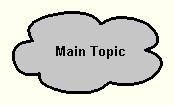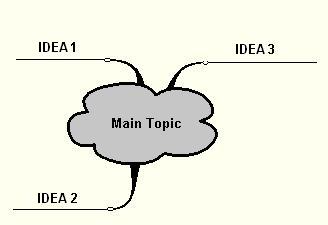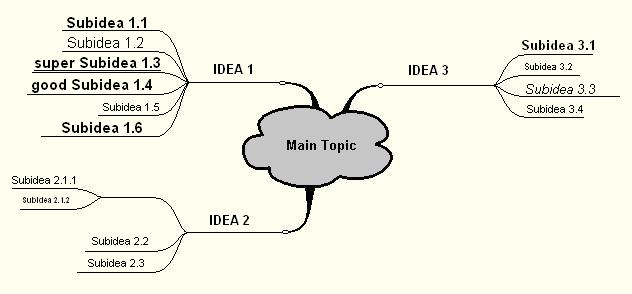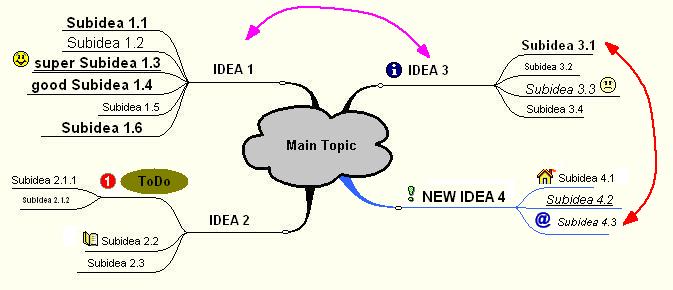Teaching:TUW - UE InfoVis WS 2008/09 - Gruppe 09 - Aufgabe 1 - Mind Map: Difference between revisions
No edit summary |
No edit summary |
||
| Line 1: | Line 1: | ||
== | ==Short Description== | ||
A mind map is a graphical diagram which shows relations between different terms. | |||
==Introduction== | |||
[[image:MindMap.jpg|thumb|Hand-drawn Mind Map]] | [[image:MindMap.jpg|thumb|Hand-drawn Mind Map]] | ||
Mind Mapping was introduced by Tony Buzan in 1974. He argued that using all the advantages of a human brain is to combine logical ideas with graphical arrangment. The method of the Mind Mapping is based on the conception that the brain is divided into two halves. The functions of the left brain half (like logical thinking, forming terms, thinking in individual components) are usually more strongly used than the functions of the right brain half (to think in pictures, in general contexts). A linkage of these two function modes can be achieved by illustrating the Thought Map, thus the Mind Map. A finished Mind Map is an overall view of the thought process with individual thought paths and elements. | Mind Mapping was introduced by Tony Buzan in 1974. He argued that using all the advantages of a human brain is to combine logical ideas with graphical arrangment. The method of the Mind Mapping is based on the conception that the brain is divided into two halves. The functions of the left brain half (like logical thinking, forming terms, thinking in individual components) are usually more strongly used than the functions of the right brain half (to think in pictures, in general contexts). A linkage of these two function modes can be achieved by illustrating the Thought Map, thus the Mind Map. A finished Mind Map is an overall view of the thought process with individual thought paths and elements. | ||
Revision as of 01:17, 22 November 2008
Short Description
A mind map is a graphical diagram which shows relations between different terms.
Introduction
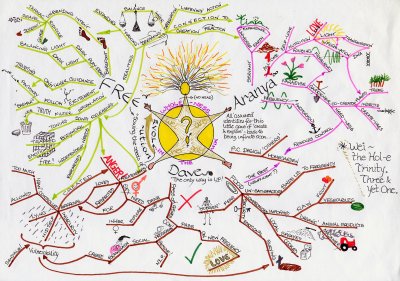
Mind Mapping was introduced by Tony Buzan in 1974. He argued that using all the advantages of a human brain is to combine logical ideas with graphical arrangment. The method of the Mind Mapping is based on the conception that the brain is divided into two halves. The functions of the left brain half (like logical thinking, forming terms, thinking in individual components) are usually more strongly used than the functions of the right brain half (to think in pictures, in general contexts). A linkage of these two function modes can be achieved by illustrating the Thought Map, thus the Mind Map. A finished Mind Map is an overall view of the thought process with individual thought paths and elements. At first ideas are visualized unordered and unvalued. They are written into the Mind Map like they emerge during the process of thinking. The process of ordering is used at a far later time. The elements of a given Mind Map are arranged intuitively according to the importance of the terms. Sometimes Mind Maps may also aid recall of existing memories.
How to generate a Mind Map
- In contrast to traditional recordings the first step is to write down the central idea (or the central topic) in the center of a sheet.
- On the basis of the central idea the user associates further subranges, which are connected with this idea. These can be noted directly on the map or on a separate sheet. The most important ideas are written on lines, which are connected with the central idea (so-called main branches). These should be noted in block letters which makes reading and reminding easier. Drawings can be used to get an "optical rhythm" into the Mind Map.
- In a third step the main branches can be arranged again into other branches (so-called sub branches). The partitioning can be continued on to a second, third and further levels. These terms should be graphically designed in a way that they can be distinguished easily as well (however not in capital letters as this refers to the main branches).
- An important thing is that apparently coincidental changes of direction are allowed. Another branch can gain the focus without finishing the last one. Also a basic idea of Mind Maps is to always use short terms like key words, references or abbreviations (NO sentences!). The use of color is always desired. It helps to connect ideas written at diffrent places. Whereever it is possible a visual representation is another good choice. Not only symbols (e.g. arrows) but iconographical icons (like smileys and other well known symbols) are popular.
- The main and sub branches form the framework of a Mind Map. After generating the Mind Map it is revised (can also be done at a later time to refocus the creative output energy). Missing associations are supplemented, if necessary a restructuring of the Map is made. Beyond that it should be examined whether some cross connections between main and/or subbranches exist.
Fields of application
- Mind Mapping as a presentation techniques
- This is about the presentation of knowledge. Mind Maps are prepared by an experts for a certain field of knowledge and used as an additional source to spoken or written text. This helps the audience learning complex facts faster.
- The use of Mind Mapping techniques as teaching strategy is recommended particularly in connection with conceptual knowledge (e.g. economic circulation, financial and bank systems, etc.). Another possible application is for example the representation of action diagrams as well as the use of Mind Maps for listing contents of a new topic. In some situations it should be considered not to present completed Mind Maps, but to be develop and discuss together.
- Mind Mapping as learning and thinking strategy
- The aim is to generate an own Mind Map. A topic is declared and then existing knowledge as well as conceptions, ideas and associations are written down. As a next step the results could be compared, discussed and supplemented with other findings.
- Apart from structuring existing knowledge Mind Maps can be used vice versa, for example to get information out of a (structured) text. The important thing is to collect information and put it together in a Mind Map. A text passage could be read, all keywords underlined and the output graphically designed in a Mind Map. As a further step related information could be written into the Mind Map too.
- Another field of activity is to remember old knowledge. By learning new content it is often reuqired to reproduced this knowledge at a later date. For the human brain it is easier to have as many related connections as possible to the topic. So it helps to remember when trying to apply the same Mind Map. Afterwards both Mind Maps could be comared and differences could be especially highlighted.
- Mind Mapping as resource
- Mind Maps could be used in group discussions to substantiate the problem space. The visualisation shows to all members on which topic to focus, an overview is always available. Reportedly discussions are more coordinated and structured as well as conflicts can be located and solved easier.
Advantages of Mind Mapping
In contrast to traditional recording techniques the advantages of the Mind Mapping method are as follows (like the inventor Tony Buzan calls them):
- The main idea is clearly in sight and it can be gatherd fast and easily.
- Because of main and subbranches the adjustment of ideas is implicit. Information near the main idea is importatnt whereas terms near a boundary have a lower meaning for the whole content.
- Important aspects are connected through lines.
- New pieces of information can be added easily because of structure and setup of a Mind Map.
- Mind Maps are open-ended. Information can be added everywhere at any time, so new linkage of ideas is possible.
A relevant problem consists of the fact that the acceptance is rather small amoung persons who are not familiar with this method. The Mind map looks unclear, confusing and nested.
References
[Buzan et al., 1999] Tony Buzan, Barry Buzan. Das Mind-Map Buch. Landsberg a.L., 1999, S. 89f.
[Chuck Smith] Tony Buzan, Created at: 27.01.2002, Retrieved at: 6.11.2008, http://en.wikipedia.org/wiki/Tony_Buzan
[Chuck Smith] Mind map, Created at: 27.01.2002, Retrieved at: 6.11.2008, http://en.wikipedia.org/wiki/Mind_map
[Jakob Voss] Gedächtniskarte, Created at: 30.05.2003, Retrieved at: 6.11.2008, http://de.wikipedia.org/wiki/Ged%C3%A4chtniskarte
